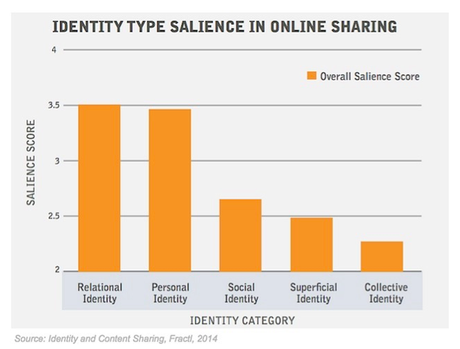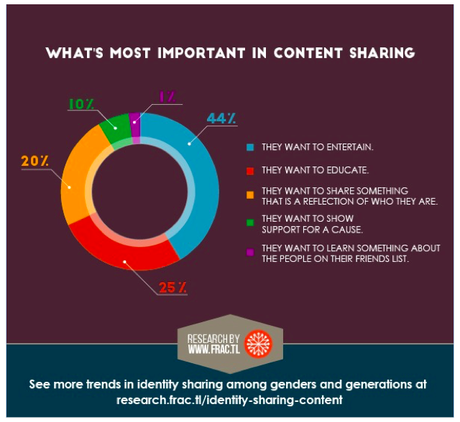 What we share through social networks is usually driven by our personal and social values, and has become an important part of how we shape our online identities. What we choose to share can reveal a great deal about our likes and dislikes, our interests, and our motivations.
What we share through social networks is usually driven by our personal and social values, and has become an important part of how we shape our online identities. What we choose to share can reveal a great deal about our likes and dislikes, our interests, and our motivations.
In short, the types of content we share says a great deal about who we are and how we would like to be perceived.
To better understand the motivation to share, the team at creative digital agency Fractl surveyed more than 1,000 people across the U.S. to learn how identity and content sharing are linked.
We prioritize different aspects of our personalities
The survey used an abbreviated version of the Social Science Aspects of Identity Questionnaire to rank the relative importance of five broad facets of identity:
- Personal Identity – Personal values and morals.
- Relational Identity – Commitment to family and friends.
- Social Identity – Popularity, physical appearance, etc.
- Collective Identity – Factors relating to generation, race, and religion.
- Superficial Identity – Material possessions, age, and gender.
The study revealed that while all of these factors form an individual’s identity, some can be more influential than others.
Consider this quote from Dr. RC Morris of Purdue University, which the report’s authors cited to illustrate the importance of identity in sharing content: “As individuals we rank the many aspects of our identities in a hierarchy. The higher an identity is ranked, and the larger and more important the social network associated with that identity, the more likely it is that we will take action to strengthen or reinforce that identity.”
This hierarchy is clearly something to consider when targeting content to a particular audience. Here are a few more highlights from the Fractl report:
- Relational identities were reported as the most important. Eighty-four percent of respondents said “relationships” and “being a good friend” were highly valued — something particularly true among the 65+ age group.
- Personal identity was also rated highly, with 63 percent reporting their inner beliefs and emotions were a strong motivation when sharing content. Younger age groups rated personal aspects more strongly than their older counterparts.
- The social aspects of popularity, including reaction from others, were ranked third by respondents, with men rating this slightly higher than women.
- The majority of respondents ranked superficial and collective identities as least important. Respondents 35+ appeared to be more aware of shifts in generational values.

Shared content has a purpose
The survey found that the top reason for sharing is a desire to entertain (44 percent), with education (25 percent) and wanting to “share something that is a reflection of who I am” (20 percent) rounding out the top three.
Of course, low priority doesn’t necessarily translate into fewer shares. The report notes that while “13 percent of women and eight percent of men ranked altruism as the most important reason they share, (but) 44 percent of women and 27 percent of men said they’d shared content to support a cause in the past week.”

There are also some interesting differences highlighted between generations and genders:
- Men reported sharing more than women, but women expect more engagement from their friends.
- Boomers (ages 41 – 65) expect more engagement from friends than the other age groups.
- Those in the youngest age group (18 – 21) were least likely to share at all, followed by those 65+.
- Overall, more than 85 percent of respondents said they posted on social media at least once a week.
This is clearly a complex area with many differences in behavior depending on age, gender, and personal values.
For me the message is simple: People want to share entertaining, informative, and relevant content. Give them that, and they’ll share your content enthusiastically to reinforce who they are and what they find valuable.
If you would like to find out more about this interesting report you can download it at Identity and Content Sharing (registration required). Alternatively, the results have been condensed into an infographic and shared through MarketingProfs.
Additional Resources on this topic:
Psychological Stress and Social Media Use
How Social Media Has Changed How We Communicate
British people are sharing how they voted on social media — and it could get them in trouble
Photo Credit: Madalina Balaban via Compfight cc

